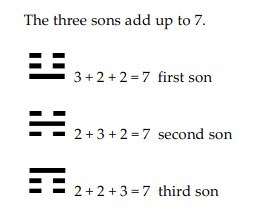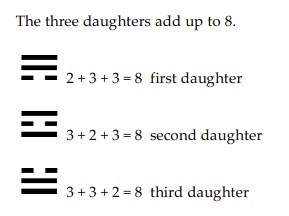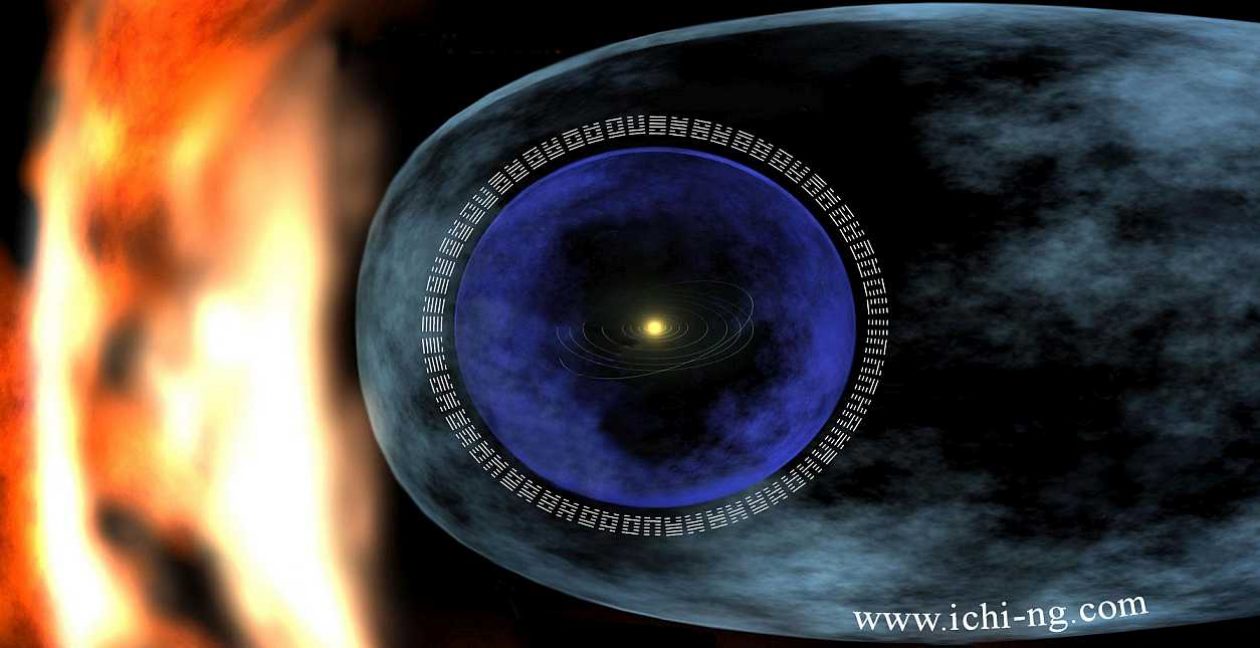Nature of the Trigrams
This chapter introduces the mathematical rationale for the structure of the hexagrams without consideration for the natural sequence or associations.
The basis for this association is the belief in the relevance of odd and even numbers.
Odd numbers represent a masculine or yang factor.
Odd numbers cannot be divided by two therefore they are firm, undivided and light and represent the way of the superior man.
Even numbers can be divided by two, therefore they are weaker.
Even numbers represent the yielding, the divisive and the dark.
Even numbers represent the feminine or yin factors.
They therefore represent the way of the inferior female.
Originally in the sequence of earlier heaven, the four males: three sons and father were the four trigrams on the daylight increasing half of the year.
In winter, the first son and then the second son.
In spring, the third son and then the father.
This was the increasing light half of the year leading to the greatest brightness.
The four females: three daughters and mother were the four trigrams on the darkness increasing half of the year.
In summer, the first daughter and then the second daughter.
In fall, the third daughter and then the mother.
This was the increasing dark half of the year leading to the greatest darkness.
The odd-even factor added new considerations within the trigrams and hexagrams.
Unfortunately they came with a rearrangement of the sequence from a natural order to one of random pairs of opposites.
This odd-even later world arrangement marked the beginning of the mathematical era and the commencement of marginalizing and distorting the astrological or natural factors of earlier heaven.
1. The light trigrams have more dark lines, the dark trigrams have more light lines.
The light trigrams have more dark lines, the dark trigrams have more light lines.
This does not refer to all of the trigrams.
Here the light three lines of the father and the dark three lines of the mother are omitted.
It refers to the new trigrams of the three sons and the three daughters in the arrangement of later heaven.
The trigrams of the three sons each have one solid line and two broken lines.

The trigrams of the three daughters each have one broken line and two solid lines.

This seemingly simple deduction represented a change of trigram interpretation from factors based on increasing light and increasing darkness.
The Male Trigrams
Fu Hsi’s Early Heaven Sequence King Wan’s Later Heaven Sequence

The first son remains in the same place in both systems.
This change seems to imply the second and third son were more effeminate.
The second son changed from clarity and fire, to abysmal dangerous water.
The third son changed from happy confidence the lake, to the keeping still mountain.
In the subsequent culture of later heaven the first son was given a significant preference.
The Female Trigrams
Fu Hsi’s Early Heaven Sequence King Wan’s Later Heaven Sequence

The first daughter remains in the same place in both systems.
This change seems to imply the second and third daughter were more masculine.
The second daughter changed from abysmal dangerous water, to clarity, fire and dependency.
The third daughter changed from the keeping still mountain, to the joyous lake and pleasure seeking.
The natural order of the family was changed.
The second and third son were made weaker and less important.
The second and third daughter were made stronger and less proper.
This has been a major variation and it has been perpetuated as valid since 1200 BC, the beginning of later heaven.
This was the work of The Duke of Chou and his father King Wan.
The first son had the solid, light or odd line in the first place.
The second son had the solid, light or odd line in the second place.
The third son had the solid, light or odd line in the third place.
The father remained all solid, light or odd lines.
The first daughter had the broken, dark or even line in the first place.
The second daughter had the broken, dark or even line in the second place.
The third daughter had the broken, dark or even line in the third place.
The mother remained all broken, dark or even lines.
Thus the new mathematical order was established and the old sequential order was left behind.
This also marks a distinct deviation from the traditional respect and worshiping of ancestors, to the accepting of the new system and making King Wan, the Duke of Chou’s father, as the correct ancestor to worship.
2. What is the reason for this? The light trigrams are uneven, the dark trigrams are even.
What is the reason for this? The light trigrams are uneven, the dark trigrams are even.
If you assess the solid lines as odd or 3 and the broken lines as even or 2, when you add up the line numbers in the trigrams of the sons each of them will add up to 7.

The total result of the addition for each of these trigrams is odd or 7, therefore these trigrams were now considered to be the sons.
Their oddness made them male!
In the arrangement of earlier heaven it was the increasing light factor that made the sons male, or active and strong.
Now in the arrangement of later heaven it was the numbers!

The total result of the addition for each of these trigrams is even or 8, therefore these were now considered to be the daughters.
Their evenness made them female.
In the arrangement of earlier heaven it was the increasing darkness that made the daughters receptive, passive and yielding.
Now in the arrangement of later heaven it was the numbers!
3. What is their nature and how do they act? The light trigrams have one ruler and two subjects. They show the way of the superior man. The dark trigrams have two rulers and one subject. This is the way of the inferior man.
What is their nature and how do they act?
Here a question directs the attention to mathematical associations and away from natural deduction. It made the mathematical reasoning appear valid.
The light trigrams have one ruler and two subjects. They show the way of the superior man.
The one ruler is the one odd or firm line.
The one solid line rules the two broken lines.
This is what the superior man does.
The dark trigrams have two rulers and one subject. This is the way of the inferior man.
The two rulers are the two solid lines.
One broken line must yield to the two solid lines.
It is weak and must follow two rulers.
This is the way of the inferior man and of women.
Here there is a negative assumption that women or the yin factor, cannot be loyal to one ruler.
Thus they would need to be controlled and prevented from wandering.
A more appropriate view would be that women are concerned about their husband and their children and as such have two driving concerns.
Thus a new masculine dominated era (later heaven) came into being and replaced the original natural ways of life.
